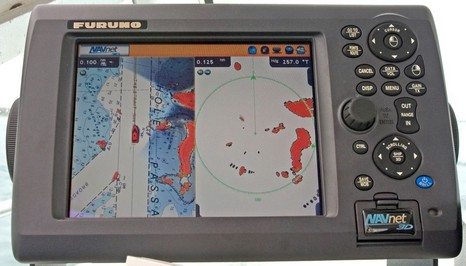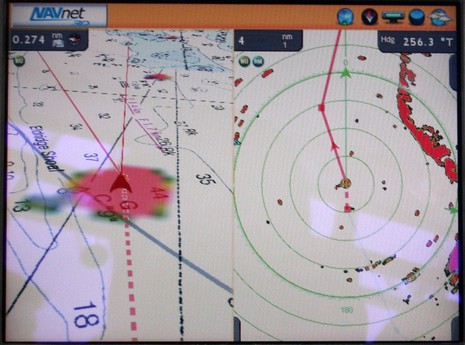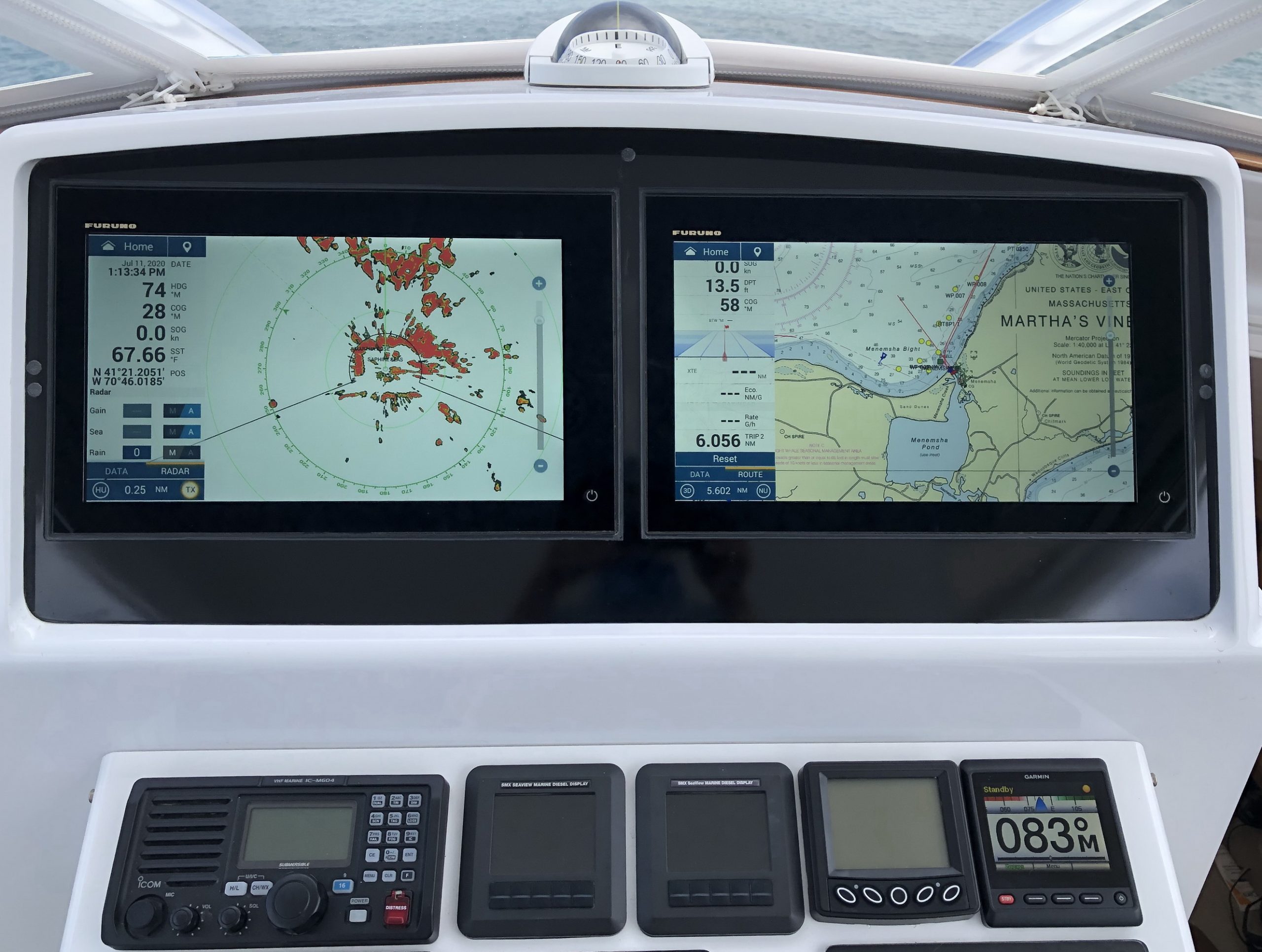HD radar, especially Furuno’s

I have a gripe about High Definition radar, or Ultra HD or Super HD or whatever; as best I can tell there is no identifiable technology, specs, or benchmarks to compare one with another, or even to grasp what it is. But it definitely is something. I’ve seen screen shots of Northstar/Simrad HD that looked good, I’ve heard excellent reports on Garmin’s HD and Raymarine’s, which I also saw myself, though only in tight quarters and flat water. But last week I spent nearly six hours inshore and off with a Furuno UHD 4kW 3.5’ array, and…wowsuh, I was definitely, and highly, impressed.
Check a bigger version of the photo above. Note how noise-free the image is, and we hadn’t done any manual tuning. Note how crisp the shorelines are and how spot-on the buoys (super good heading info helped, more on that later). Note too on the overlay how you can see a bit of the boat’s wake. I think we’d slowed down here in Wood’s Hole; much of the day—flat water and inefficient boat, mind you—we could clearly see our wake, which is really reassuring in terms of seeing something small and close ahead. In fact, we later tracked a cormorant flying maybe two feet over the water a few hundred yards away. And when we set a guard alarm at a mile, the first thing to set it off was another bird. I also tried ARPA automatic target acquisition, which I don’t think any other radar in this category offers, and it worked well. All in all, I rapidly developed a high confidence level in this UHD radar, but, as noted above, can not easily compare its performance with other HD sets.
I did notice one oddity, seen below. See how fuzzy the overlay looks (and sorry about the glare)? That’s only because the chart is zoomed to about a quarter mile (NN3D zooms in small increments or standard ones, your choice), while the radar is at four mile range. Hence NN3D had little data to overlay on the chart at left and fudged it. I’ll bet that if I’d ranged the radar in (they can be synched), you’d see a clean buoy target where that green smudge is, and our wake behind the boat. But it’s hard to call this an issue, because what other system even comes close?














Ben,
Interesting rundown. Thanks for trying out the automatic ARPA on the Furuno set. As you know, I wish Raymarine would incorporate this feature on its radars. It would be a helpful aid in collision avoidance offshore.
I’m still waiting for my new Raymarine 12 kW Super HD scanner, but even the 4 kW Super HD unit I have for now is impressive, as you stated.
Preston
I was thinking of you, Preston. Have you been seeing birds on your 4 kW Super HD?
I understand Furuno doesn’t have 12 kW UHD scanners yet either (correction: it’s the 25 kW units that won’t be delivered for a while), and spoke with a guy today who got the same 4 kW I tried but hasn’t gotten his mitts on its power supply yet.
Ben,
The oddity you describe in the image that is seen as a red “Blur” around the vessel is the actual transmit pulse of the radar transmitter.
The radar is transmitting on a four mile scale which requires a longer transmit pulse than what is required for a 1/4 mile chart scale. In this split-screen case, the radar range has priority and over-rides the automatic synchronization which would normally match the radar pulselength to the overlayed chart range.
Theoretically, the transmit pulse could be masked but, it might unintentionally hide a close target.
The oddity is normal and a function of the physics of the radar system. You are correct in surmising that zooming in the radar display will sharpen the picture because the pulselength will shorten providing much better resolution and a cleaner radar return image from the digital processor.
OK, this is just marketing gone bad. Here in LA we have “channel 7 double doppler HD 7000 weather radar”
Every time I here them say it, seriously. I seriously crack up. The “HD’ is bs it;s the same radar all the staions have, “double doppler” yeah that’s the same two NOAA radars everyone else in LA has. “7000” gimme a break. But I have to say I am in awe of people who can take nothing and turn it into something.
Don’t get me started on competing weathermen “Johnny mountain” and “Dallas Rains” (I couldn’t make it up if I tried)
The first people to have ‘hd’ radar should have trademarked it I guess…
I am definitely not up on this technology, but my understanding was that higher resolution radars came from shorter transmit pulse widths. Ben, have you compared the HD pw to the non-HD pw? Also, are the HD pw’s similar?
Of course, it could be some DSP magic that they are using — sort of like 1 bit D/A converters.
Great blog Ben, I read it every day. Thanks for your efforts on AIS, you may save some lives in the process.
Ben thanks for the summary. A general radar question – given the choice of installing a Furuno 2kW or 4kW radar system on a sailboat, what should drive this decision? Is it a range vs. power consumption equation? Does the 4kW system use twice the power of a 2kW? Feedback & opinions welcome! Thanks. Mike
Ben,
No birds yet on the Raymarine HD radar, but I did track an airliner that crossed in front of me off Palm Beach by quickly setting it as a MARPA target. The radar followed it with speed readings (up to 160 knots) all the way to the ground at Palm Beach International, and continued showing it while it taxied around! I wish I had taken a screen shot of that!
Preston
Mike – In the NN3D brochure, Furuno only quotes a 4W difference in power consumption between the 2kW and 4kW domes.
It is exciting to read about all this new technology but, the problem I see with it is, that it is beyond reach and means for the average boater.
The first sentence sums it up; so far we have only marketing and nothing for a techie to grok. There are some comparison HD vs non-HD screen photos on Garmin’s blog. They point out the differences as more and bigger targets on the display. But they don’t say what those blips actually are, so I don’t know if they should or should not be on the screen. The bottom line for me is whether the blip is a collision hazard or not.
The DSP magic could be like doing Photoshop on the radar picture. Or it could be in handling the received pulses before building that picture.
Good point, Norse, on the lack of tech specs. As the Furuno Tech pointed out, the red area in the screen shot is the “main bang” (the radar pulse in radar speak). The range of the MB from ownship should reflect the pulse width. It should be the radius of the red region divided by the speed of light (186282.397 miles/sec) — assuming Furuno does its math in statutory miles. So, assuming the .274 range is from the center of ownship to the right edge of the chart display, that makes the size of the MB about .137 miles. After the math, that makes the PW 735 nano seconds. Compare this pulse width to the width of an older radar (Furuno 1623 seems to have an 800 micro second pulse width at 4 miles according to a quick internet search), and that might explain the “HD.” Wow, that is a 1000 times finer pulse width. (This explains why you could see the bird). Then again, my calculation could be all messed up as it has been a long time since I seriously looked at radar stuff.
I want to point out that “Furuno Technician” posted anonymously–i.e. no email or web address–and that makes me nervous. Furuno doesn’t need or want representatives who really aren’t. But that said, FT’s information seems very good. As do several other posts. I’m learning things here. Thanks!
Ben- I am a radar designer by trade (over 34 years) and I have several comments to make. I’m using my home address but I am for real.
HD, UHD etc etc are still using good old fashioned Magnetron Radar transmitters and the same old pulse lengths they always have. The HD, SHD, UHD stuff is coming strictly from signal processing changes. In the old days analog “video” pulses from the radar were converted to “dots” on the screen using simple analog threshold detection methods. That allowed both noise and targets to appear on screen. Now however they are using high speed A/D conversion with many bits (10 – 14) to digitize the video without things like analog threshold detectors that allowed everything that crossed the amplitude threshold to light up the screen.
Once the unfettered video is digitized by the high dynamic range A/D converters (14 bits is 84dB in theory) they can perform coherent integration of sucessive pulses, require successive detections to exclude noise, they can implement adaptive detection thresholds (eliminates noise) all using smart algorithms in the Digital signal processing.
That has dramatically cleaned up the screen but nothing has changed for range resolution (Pulse length) and Cross range resolution (antenna beamwidth).
There is another radar technology that has not yet been used in this venue because up to now it was super expensive. Its called Pulse Compression Radar. The real value of this technology is in solving the “red blur” you found when zooming. Pulse compression allows a radar system to maintain the SAME RANGE RESOLUTION Vs Range because its range resolution is NOT tied directly to the pulse length.
Most Maggy radars use pulse lengths from about 70 nanoseconds (0.07 microseconds) to less than 2 microseconds depending on range to the target.
The Magnetron is constrained to exceptionally low duty cycles (on to off ratios) such that the average power of a 4KW radar is about 40W for a duty factor of 0.01. But pulse compression radars are designed for duty factors over 10 times Longer of 0.1 or 0.15. They use modulation DURING the pulse to provide the needed range resolution and some very fancy signal processing. We have replaced former 60Kw Magnetron Aviation radars with 40W peak solidstate radars that can see storms in more detail than ever before out to 300 Nmi.
So try to imagine zooming in to that bouy reflector and seeing it with 15ft range resolution and not a few hundred feet like your display shows. THAT will be UHD radar – called PUlse Compression Radar. Recall Kelvin Hughes? They just certified their Pulse Compression radar – but they focused on Doppler rather than range resolution in their pulse compression system.
Now I have a question for you – if you can see a mallard fly by – how will wave clutter be rejected? If you can detect your wake- how will wave clutter be rejected? I don’t see these things as necessarily good. Let me know when you get to see these systems at work in 25Kt blow and 3-4ft seas.
DavidV,
Very informative comments; thank you. I have recent experience with a Raymarine 4kW Super HD unit in 20 kt winds with 5-6 ft seas off the North and South Carolina coast. There were a fair number of small center console fishing boats out that day, and my radar screen showed minimal sea clutter at all ranges in the Offshore mode with default settings at a 6 nm setting, and easily displayed these boats long before I could visualize them. It was interesting to watch the display as faint, distant targets were first detected, first as a faint return, and then on subsequent sweeps as a much stronger, “confirmed” object. This was with moderate pitch plane boat motion, running at 25 kt, in the sea state as described above.
Preston
Thanks, DavidV. And you too, Preston. Sounds like one heck of a boat ride!
PS. Readers can learn more about Preston’s brand new Riviera 45 because it was used in a PMY boat test written by my buddy Bill Pike:
http://tinyurl.com/5nyxyq
Preston- Thanks very much. That means they have taken advantage of capabilities now that the data is digitized and stored in memory. They can do a better job of “scan to scan correlation (each 360 rotation is a scan)” – that’s what’s happening when detections continue to brighten and become more solid.
They also appear to be taking advantage of detection persistence or “decorrelation of clutter”. In other words, wave responses change from moment to moment (in milliseconds) where as man-made targets tend to remain fixed with less variation in amplitude response in the short term (again a period of milliseconds perhaps a fraction of a second).
Man-made objects also tend to reappear in virtually the same place from scan to scan – but waves have morphed completely in that time. So getting rid of sea clutter is much better with digital data that uses “smart” detection in the first place and then is correlated among PRFs and scan to scan. That’s not possible with typical video / analog methods.
David V is correct in that these so-called “HD” benefits are not the result of transmitter enhancements. Marine radar is still hostage to a mere vacuum tube…the magnetron.
Aviation weather radar in today’s skies uses a solid state low power transmitter (100 watts peak in airliners, and in the regional/corporate jet arena 25 watts peak). This is achieved (by one manufacturer I am familiar with) by using impatt diodes as the final transmitter power output stage. Very long range (150-200NM practical) weather avoidance capability is attained with only 25 watts peak. By having an extremely stable output pulse (not “pulse compression” as David V stated…but more accurately pulse stability), receiver selectivity can be cranked down to the proverbial “gnat’s fanny”. This greatly reduces noise, increases *loop gain* (the round trip out-and-back gain), thus permitting very low level target detection. An important benefit is that the transmitter signal is so stable, that on short ranges (25NM and less) it is possible to see the doppler shift caused by water droplet motion in the atmosphere and display that on the pilot’s display as turbulence. It is truly a “solid state” “doppler weather radar”…not a marketing phrase, but in reality.
Alas, in the marine world we still have the senior citizen magnetron, now coming up on 70 years of ubiquity. It’s time to drive a stake trhough its heart. It is a vacuum tube, thus no marketeer can claim a “solid state radar”; it is unstable; it splatters – wastes – energy over a wide spectrum forcing receiver selectivity to be as open as a barn door, thus allowing in lots of noise; its frequency shifts within its pulse length; it radiates all who come within a certain distance of it, thus potentially causing leukemia and other health problems down the road; it is a power hog; and it’s a consumable with limited life.
The “HD” manufacturers have done wonders, or so I read…but it isn’t in the transmitter. It’s digital processing of the received signal, each manufacturer doing its thing a little differently, thus the reason no specs exist for comparing such apples to oranges.
Kudos to them for what they have done with manipulation of the received signal.
First, Can I match my raymarine C-80 display to an older Furuno RSB-0061 antenna?
If so will I be able to use the old Cable code 000-138-970-00.
Second, where can I find a cable replacement to do the job? I bought the antenna without the cable.
Thanks, any info will help alot
Sorry, Philip, not a chance. There is virtually no radar scanner that will work with another brand’s display, and there are even compatibility issues within the same brand’s various model generations.
However, most newer model scanners use Ethernet for data and control, instead of proprietary cables, which means we are closer to the possibility of multi-brand radar scanners. But we’re not there yet.